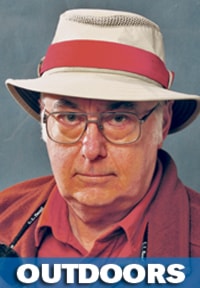My days of yore were always crazy daze around the autumnal equinox. The rig was a constant confusion of fishing tackle, waders, dogs and their gear, decoy bags, shotguns, shells. …. When we left on a Saturday morning, we seldom knew where we were going or what we’d be doing: some fall fly fishing, maybe, grouse hunting, perhaps, water fowling, what? Sometimes all of the above.
They tell me it is even better, now that Sunday hunting is lawful in most of the province.
Unfortunately, my rig’s load is now reduced to a walker in the back, maybe a camera or two, and sometimes my new scooter on its trailer hitch platform.
This is a vintage year for fall colours. The early equinoctial storm and killing frost that followed it were not sufficient to kill the green leaves and rendering them dry and dull gray as a big blizzard and following freeze did on Sept. 14 a few years ago.
Fall fishing was always my favourite, not the least for the glorious colours of the foliage.
But the storm and freeze that was not enough to kill the colour seems to have slowed the usually fascinating fall fishing in Alberta’s best trout areas. From the southwest corner of the province to west Central Alberta, anglers are reporting cold and cloudy rivers and streams and very slow fishing, the result of the snow runoff from that storm.
Surely, everyone hopes, things will pick up with this hot run of ‘First Nations’ summer?
A report, as I write this, tells of some recent really hot fishing to backswimmer and water boatmen hatches on various west Central Alberta stocked lakes. If the warm spell continues, rivers and streams should clear, warm and provide action to big brown, brook, and even bull trout spawners as they move upstream and pause occasionally to feed-up on the fall protein provided mostly by terrestrial insects: beetles, grasshoppers and ants.
Occasionally in the fall, there will be a good aquatic insect hatch, mostly various species of caddis flies, occasionally the giant fall, or October caddis, that can really put the trout on “the bite.”
We’ll have more dull, drizzly, cool days before freeze-up, and that often produces a hatch of the tiniest blue-winged olives that the trout often prefer to even the meatiest terrestrial insects. Some becalmed anglers have been enjoying a late summer, early fall wild mushroom bonanza: aspen bolete, the provincial mushroom, and particularly roadside of regiments of shaggy manes emerging in the heat after the snow melt.
Back in the 1960s, we had regional Fish and Wildlife biologists who actually worked in the field instead of dinking away at computer models like the do today.
They actually did spring drumming counts to accurately assess ruffed grouse population numbers. Without such counts, it is hard to get a reading on ruffed grouse numbers because, to start with, the people who hunt them seriously are secretive sorts and often wait to get started until a good wind or two improves visibility by blowing those colourful fall leaves away.
Neil Waugh, outdoors columnist for the Edmonton Sun and his Labrador, Penny, are ruffed grouse fanatics, but have been out only once, so far.
They got one flush that time, but, Neil says, “I didn’t see the bird because of all the leaves.” Since then, it has been too hot. “I hate hunting in the heat,” Neal says, “when there are mozzies about.”
With regard to counting other upland game, there are people, like Rick Martin, wildlife projects manager for the Eastern Irrigation District at Brooks, who actually get out in the spring dawn darkness and do pheasant crowing counts and spy on leks, sharp tail grouse dancing grounds. This spring’s counts showed promise for the pheasant season starting Oct. 15, with a surprising bonus of good sharp tail numbers.
Martin says that after a long, hard winter, he was pleasantly surprised with the spring upland bird counts in the EID. Pheasant crowing counts were up 43 per cent from 2013, just five per cent below the 35-year average, and sharp tail lek counts were up 42 per cent from last year, and an astonishing 35 per cent above the 18-year average. But the spring counts are never the whole story with upland birds in Alberta. The nesting success of those birds counted in the spring is critical to the bird numbers in the fall. From the reports I am receiving from landowners and other serious observers in upland country of bunches of birds showing up recently, the nesting season was a success with high chick survival, mainly owing to favourable weather conditions in late May and on into June.
This fall equinox multi-tasking time generally ends with the start of many big game seasons on Nov. 1. An angler who was “enjoying” six hours of slow time on Stump Ranch water recently reported sighting half a dozen white tail does and predicted “there’ll have to be some bucks around in November.” Yes, there always are. …
Bob Scammell is an award-winning columnist who lives in Red Deer. He can be reached at bscam@telusplanet.net.
